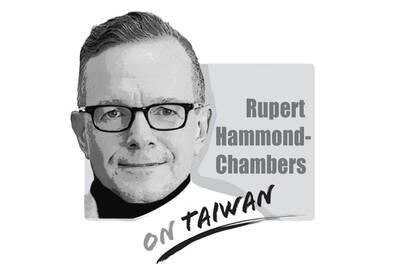Who controls whom?
It would surely come as some relief to Robin Winkler to know that he is safely mistaken in his diagnosis of what ails Taiwan (“Who speaks for the rule of law?” Aug, 28, p 8).
Winkler’s chastisement of the Chinese Nationalist Party (KMT) for undermining “the rule of law” is at best a superficial analysis and perhaps even a dishonest one.
The facts to support his argument may be clear to see, but, by framing them in the context of “the rule of law” he diffracts the light away from the true nature of what is happening — this is not simply the behavior of a “rough” executive, Taiwan is quite literally being invaded.
First, there was not, is not, nor can there ever be, a single example of when Winkler’s so-called “rule of law” does not devolve to, or in the more salient cases degrade to, the rule of men.
For sure, there are ample questions as to the degree to which that may occur, but the relevant point is that Winkler’s “rule of law” has always been little more than a rhetorical flourish promoted by popular ignorance of the status of what he calls a “fundamental value of Western society.”
It is not and nor does it make any sense to think of it as such. The obvious question to put to him would be why the overall design of the legal architecture in the US, which he refers to with such mendacious phrasing, was designed in the way it was in the first place?
The answer to that question is that the US legal system was designed with the specific intent of limiting the powers of government and protecting the freedom of the individual.
This idea was, is and always will be anathema to Chinese (and not only Chinese) conceptions of society.
The failure of democratic government in Taiwan to prevent the degradation of the “rule of law” into this sinister “rule of party” is neither unique, nor should it really be a surprise. In fact, the US itself furnishes any honest student with plenty of examples of this trend, both historical and current.
The warping of democratic government in Taiwan may have been exacerbated by the pre-existing organizational power of the KMT, but even that itself can be fully explained by an initial design flaw — a central, unified legal architecture that concentrates political power under a territorial monopoly rather than diffuses power as far as possible toward the individual.
The last time Taiwan was plunged from the beginnings of Western enlightenment into the barbarity of two centuries of Chinese darkness came about as the result of the sudden invasion of Chinese power represented by the forces of Cheng Cheng-kung (鄭成功) back in 1661.
Today, the weapons of combat are different — legal provisions for land theft instead of warships and so on — but the nature of what is happening is similar.
Perhaps a better concept for understanding Taiwan’s current problems comes from the rather unlikely source of Vladimir Ilyich Lenin and his famous formula: “who, whom?”
MICHAEL FAGAN
Tainan

In the past month, two important developments are poised to equip Taiwan with expanded capabilities to play foreign policy offense in an age where Taiwan’s diplomatic space is seriously constricted by a hegemonic Beijing. Taiwan Foreign Minister Lin Chia-lung (林佳龍) led a delegation of Taiwan and US companies to the Philippines to promote trilateral economic cooperation between the three countries. Additionally, in the past two weeks, Taiwan has placed chip export controls on South Africa in an escalating standoff over the placing of its diplomatic mission in Pretoria, causing the South Africans to pause and ask for consultations to resolve
An altercation involving a 73-year-old woman and a younger person broke out on a Taipei MRT train last week, with videos of the incident going viral online, sparking wide discussions about the controversial priority seats and social norms. In the video, the elderly woman, surnamed Tseng (曾), approached a passenger in a priority seat and demanded that she get up, and after she refused, she swung her bag, hitting her on the knees and calves several times. In return, the commuter asked a nearby passenger to hold her bag, stood up and kicked Tseng, causing her to fall backward and
In December 1937, Japanese troops captured Nanjing and unleashed one of the darkest chapters of the 20th century. Over six weeks, hundreds of thousands were slaughtered and women were raped on a scale that still defies comprehension. Across Asia, the Japanese occupation left deep scars. Singapore, Malaya, the Philippines and much of China endured terror, forced labor and massacres. My own grandfather was tortured by the Japanese in Singapore. His wife, traumatized beyond recovery, lived the rest of her life in silence and breakdown. These stories are real, not abstract history. Here is the irony: Mao Zedong (毛澤東) himself once told visiting
When I reminded my 83-year-old mother on Wednesday that it was the 76th anniversary of the founding of the People’s Republic of China, she replied: “Yes, it was the day when my family was broken.” That answer captures the paradox of modern China. To most Chinese in mainland China, Oct. 1 is a day of pride — a celebration of national strength, prosperity and global stature. However, on a deeper level, it is also a reminder to many of the families shattered, the freedoms extinguished and the lives sacrificed on the road here. Seventy-six years ago, Chinese Communist leader Mao Zedong (毛澤東)